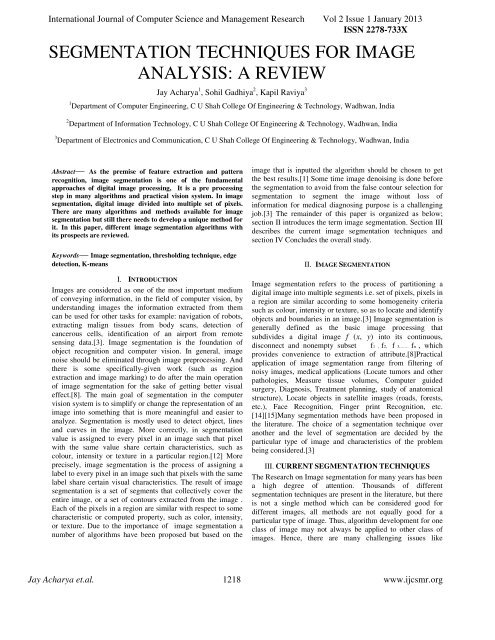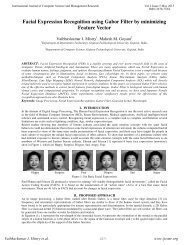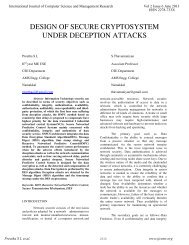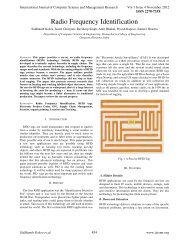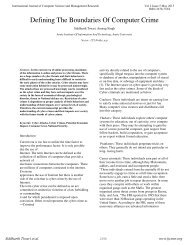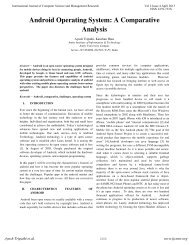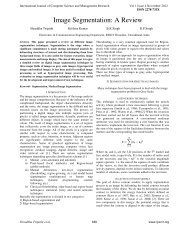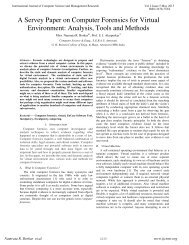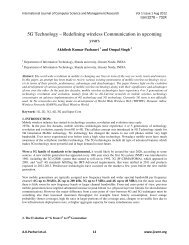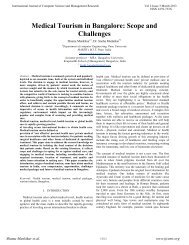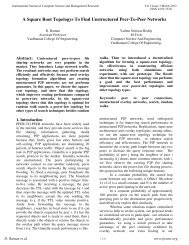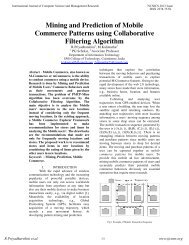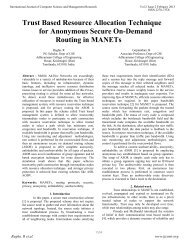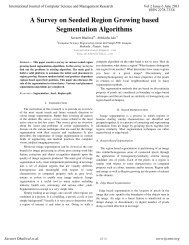segmentation techniques for image analysis: a review - ijcsmr
segmentation techniques for image analysis: a review - ijcsmr
segmentation techniques for image analysis: a review - ijcsmr
Create successful ePaper yourself
Turn your PDF publications into a flip-book with our unique Google optimized e-Paper software.
International Journal of Computer Science and Management Research Vol 2 Issue 1 January 2013<br />
ISSN 2278-733X<br />
SEGMENTATION TECHNIQUES FOR IMAGE<br />
ANALYSIS: A REVIEW<br />
Jay Acharya 1 , Sohil Gadhiya 2 , Kapil Raviya 3<br />
1 Department of Computer Engineering, C U Shah College Of Engineering & Technology, Wadhwan, India<br />
2 Department of In<strong>for</strong>mation Technology, C U Shah College Of Engineering & Technology, Wadhwan, India<br />
3 Department of Electronics and Communication, C U Shah College Of Engineering & Technology, Wadhwan, India<br />
Abstract— As the premise of feature extraction and pattern<br />
recognition, <strong>image</strong> <strong>segmentation</strong> is one of the fundamental<br />
approaches of digital <strong>image</strong> processing, It is a pre processing<br />
step in many algorithms and practical vision system. In <strong>image</strong><br />
<strong>segmentation</strong>, digital <strong>image</strong> divided into multiple set of pixels.<br />
There are many algorithms and methods available <strong>for</strong> <strong>image</strong><br />
<strong>segmentation</strong> but still there needs to develop a unique method <strong>for</strong><br />
it. In this paper, different <strong>image</strong> <strong>segmentation</strong> algorithms with<br />
its prospects are <strong>review</strong>ed.<br />
Keywords— Image <strong>segmentation</strong>, thresholding technique, edge<br />
detection, K-means<br />
I. INTRODUCTION<br />
Images are considered as one of the most important medium<br />
of conveying in<strong>for</strong>mation, in the field of computer vision, by<br />
understanding <strong>image</strong>s the in<strong>for</strong>mation extracted from them<br />
can be used <strong>for</strong> other tasks <strong>for</strong> example: navigation of robots,<br />
extracting malign tissues from body scans, detection of<br />
cancerous cells, identification of an airport from remote<br />
sensing data.[3]. Image <strong>segmentation</strong> is the foundation of<br />
object recognition and computer vision. In general, <strong>image</strong><br />
noise should be eliminated through <strong>image</strong> preprocessing. And<br />
there is some specifically-given work (such as region<br />
extraction and <strong>image</strong> marking) to do after the main operation<br />
of <strong>image</strong> <strong>segmentation</strong> <strong>for</strong> the sake of getting better visual<br />
effect.[8]. The main goal of <strong>segmentation</strong> in the computer<br />
vision system is to simplify or change the representation of an<br />
<strong>image</strong> into something that is more meaningful and easier to<br />
analyze. Segmentation is mostly used to detect object, lines<br />
and curves in the <strong>image</strong>. More correctly, in <strong>segmentation</strong><br />
value is assigned to every pixel in an <strong>image</strong> such that pixel<br />
with the same value share certain characteristics, such as<br />
colour, intensity or texture in a particular region.[12] More<br />
precisely, <strong>image</strong> <strong>segmentation</strong> is the process of assigning a<br />
label to every pixel in an <strong>image</strong> such that pixels with the same<br />
label share certain visual characteristics. The result of <strong>image</strong><br />
<strong>segmentation</strong> is a set of segments that collectively cover the<br />
entire <strong>image</strong>, or a set of contours extracted from the <strong>image</strong> .<br />
Each of the pixels in a region are similar with respect to some<br />
characteristic or computed property, such as color, intensity,<br />
or texture. Due to the importance of <strong>image</strong> <strong>segmentation</strong> a<br />
number of algorithms have been proposed but based on the<br />
<strong>image</strong> that is inputted the algorithm should be chosen to get<br />
the best results.[1] Some time <strong>image</strong> denoising is done be<strong>for</strong>e<br />
the <strong>segmentation</strong> to avoid from the false contour selection <strong>for</strong><br />
<strong>segmentation</strong> to segment the <strong>image</strong> without loss of<br />
in<strong>for</strong>mation <strong>for</strong> medical diagnosing purpose is a challenging<br />
job.[3] The remainder of this paper is organized as below;<br />
section II introduces the term <strong>image</strong> <strong>segmentation</strong>. Section III<br />
describes the current <strong>image</strong> <strong>segmentation</strong> <strong>techniques</strong> and<br />
section IV Concludes the overall study.<br />
II. IMAGE SEGMENTATION<br />
Image <strong>segmentation</strong> refers to the process of partitioning a<br />
digital <strong>image</strong> into multiple segments i.e. set of pixels, pixels in<br />
a region are similar according to some homogeneity criteria<br />
such as colour, intensity or texture, so as to locate and identify<br />
objects and boundaries in an <strong>image</strong>.[3] Image <strong>segmentation</strong> is<br />
generally defined as the basic <strong>image</strong> processing that<br />
subdivides a digital <strong>image</strong> f (x, y) into its continuous,<br />
disconnect and nonempty subset f1 , f2, f 3,…… fn , which<br />
provides convenience to extraction of attribute.[8]Practical<br />
application of <strong>image</strong> <strong>segmentation</strong> range from filtering of<br />
noisy <strong>image</strong>s, medical applications (Locate tumors and other<br />
pathologies, Measure tissue volumes, Computer guided<br />
surgery, Diagnosis, Treatment planning, study of anatomical<br />
structure), Locate objects in satellite <strong>image</strong>s (roads, <strong>for</strong>ests,<br />
etc.), Face Recognition, Finger print Recognition, etc.<br />
[14][15]Many <strong>segmentation</strong> methods have been proposed in<br />
the literature. The choice of a <strong>segmentation</strong> technique over<br />
another and the level of <strong>segmentation</strong> are decided by the<br />
particular type of <strong>image</strong> and characteristics of the problem<br />
being considered.[3]<br />
III. CURRENT SEGMENTATION TECHNIQUES<br />
The Research on Image <strong>segmentation</strong> <strong>for</strong> many years has been<br />
a high degree of attention. Thousands of different<br />
<strong>segmentation</strong> <strong>techniques</strong> are present in the literature, but there<br />
is not a single method which can be considered good <strong>for</strong><br />
different <strong>image</strong>s, all methods are not equally good <strong>for</strong> a<br />
particular type of <strong>image</strong>. Thus, algorithm development <strong>for</strong> one<br />
class of <strong>image</strong> may not always be applied to other class of<br />
<strong>image</strong>s. Hence, there are many challenging issues like<br />
Jay Acharya et.al. 1218 www.<strong>ijcsmr</strong>.org
International Journal of Computer Science and Management Research Vol 2 Issue 1 January 2013<br />
ISSN 2278-733X<br />
development of a unified approach to <strong>image</strong> <strong>segmentation</strong><br />
which can be applied to all type of <strong>image</strong>s, even the selection<br />
of an appropriate technique <strong>for</strong> a specific type of <strong>image</strong> is a<br />
difficult problem.[2][3]<br />
Based on different technologies, <strong>image</strong> <strong>segmentation</strong><br />
approaches are currently divided into following categories,<br />
based on two properties of <strong>image</strong>.<br />
• Detecting Discontinuities<br />
It means to partition an <strong>image</strong> based on abrupt changes in<br />
intensity, this includes <strong>image</strong> <strong>segmentation</strong> algorithms like<br />
edge detection.<br />
• Detecting Similarities<br />
It means to partition an <strong>image</strong> into regions that are similar<br />
according to a set of predefined criterion; this includes <strong>image</strong><br />
<strong>segmentation</strong> algorithms like thresholding, region growing,<br />
region splitting and merging.[3]<br />
CLASSIFICATION OF IMAGE SEGMENTATION METHODS<br />
Main<br />
Categories<br />
Edge Base<br />
<strong>segmentation</strong><br />
Region Based<br />
Special Theory<br />
Based<br />
Model Based<br />
Sub Classes<br />
Grey Histogram Technique<br />
Gradient<br />
Based<br />
Thresholding<br />
Region<br />
Operating<br />
Clustering<br />
Neural Network<br />
A. Segmentation Based on Edge Detection<br />
Differential coefficient<br />
technique<br />
Laplacian of a Gaussian<br />
Canny Technique<br />
Global Thresolding<br />
Local Thresolding<br />
Dynamic Adaptive<br />
Thresolding<br />
Region growing<br />
Region Splitting and<br />
Merging<br />
K-means<br />
Fuzzy<br />
Edge detection is currently becoming a problem of<br />
fundamental importance in <strong>image</strong> <strong>analysis</strong>, even if it is one of<br />
the different <strong>image</strong> <strong>segmentation</strong> <strong>techniques</strong>. In typical<br />
<strong>image</strong>s, edges characterize object boundaries, and are<br />
there<strong>for</strong>e useful <strong>for</strong> <strong>segmentation</strong> and detection of objects in a<br />
scene. [2][6]<br />
Edge detection is a term in <strong>image</strong> processing and computer<br />
vision, it refers to algorithms which aim at identifying points<br />
in a digital <strong>image</strong> at which there is an abrupt change in <strong>image</strong><br />
brightness or more <strong>for</strong>mally, has discontinuities or simply<br />
where there is a jump in intensity from one pixel to the next<br />
[6]<br />
There are many ways to per<strong>for</strong>m edge detection, however, the<br />
majority of different methods may be grouped into two<br />
categories:<br />
1. Gray Histogram Technique<br />
In this technique, <strong>segmentation</strong> depends upon the selection on<br />
threshold Thr. This method is very efficient as compared to<br />
other <strong>segmentation</strong> methods. Firstly depending upon the<br />
colour or intensity a histogram is calculated from the entire<br />
pixel in the <strong>image</strong>, and then edges and valleys in <strong>image</strong> are<br />
located. This method found difficult to use when significant<br />
edges and valleys in the <strong>image</strong>s were identified.[9][12]<br />
2. Gradient Based Method<br />
Gradient is the first derivative <strong>for</strong> <strong>image</strong> f(x, y), when there is<br />
abrupt change in intensity near edge and there is little <strong>image</strong><br />
noise, gradient based method works well. This method<br />
involves convolving gradient operators with the <strong>image</strong>. High<br />
value of the gradient magnitude is possible place of rapid<br />
transition between two different regions. These are edge<br />
pixels, they have to be linked to <strong>for</strong>m closed boundaries of the<br />
regions. Common edge detection operators used in gradient<br />
based method are sobel operator, canny operator, Laplace<br />
operator, Laplacian of Gaussian (LOG) operator & so on, [2]<br />
canny is most promising one , but takes more time as<br />
compared to sobel operator. Edge detection methods requires<br />
a balance between detecting accuracy and noise immunity in<br />
practice, if the level of detecting accuracy is too high, noise<br />
may bring in fake edges making the outline of <strong>image</strong>s<br />
unreasonable and if the degree of noise immunity is too<br />
excessive, some parts of the <strong>image</strong> outline may get undetected<br />
and the position of objects may be mistaken. Thus, edge<br />
detection algorithms are suitable <strong>for</strong> <strong>image</strong>s that are simple<br />
and noise-free as well often produce missing edges or extra<br />
edges on complex and noisy <strong>image</strong>s.[3]<br />
B. Region Based Segmentation Methods<br />
Edge-based <strong>segmentation</strong> partitions an <strong>image</strong> based on abrupt<br />
changes in intensity near the edges whereas region based<br />
<strong>segmentation</strong> partitions an <strong>image</strong> into regions that are similar<br />
according to a set of predefined criteria. Thresholding, region<br />
growing, region splitting and merging are the main examples<br />
of <strong>techniques</strong> in this category[8]<br />
1. Thresholding Method<br />
Thresholding <strong>techniques</strong> are <strong>image</strong> <strong>segmentation</strong>s based on<br />
<strong>image</strong>-space regions. The fundamental principle of<br />
thresholding <strong>techniques</strong> is based on the characteristics of the<br />
<strong>image</strong>. [5] It chooses proper thresholds n T to divide <strong>image</strong><br />
pixels into several classes and separate the objects from<br />
background. When there is only a single threshold T , any<br />
point (x, y) <strong>for</strong> which f (x, y)>T is called an object point; and<br />
a point (x, y) is called a background point if f (x, y)
International Journal of Computer Science and Management Research Vol 2 Issue 1 January 2013<br />
ISSN 2278-733X<br />
T =M[x, y, p(x, y), f (x, y)] ………..(1)<br />
In this equation, T stands <strong>for</strong> the threshold; f (x, y) is the gray<br />
value of point (x, y) and p(x, y) denotes some local property of<br />
the point—such as the average gray value of the neighborhood<br />
centered on point (x, y) . [8]<br />
Based on (1), thresholding <strong>techniques</strong> can be mainly divided<br />
into global, local, and dynamic thresholding <strong>techniques</strong>.<br />
1) Global thresholding<br />
Intensity distribution of object and background pixel are<br />
sufficiently distinct, then it is possible to use a global (single)<br />
threshold on the entire <strong>image</strong>. When ‘Thr’ depends only on<br />
the grey level value of <strong>image</strong> and ‘Thr’ is solely related to the<br />
properties of pixel in the <strong>image</strong>, this technique is called global<br />
thresholding. There are so many global thresholding methods<br />
are presented such as Otsu method, entropy based<br />
thresholding and so on.[12]<br />
2) Local thresholding<br />
If threshold T depends on both f (x, y) and p(x, y) , this<br />
thresholding is called local thresholding . This method divides<br />
an original <strong>image</strong> into several sub regions, and chooses<br />
various thresholds Ts <strong>for</strong> each sub region reasonably.[5] After<br />
thresholding, discontinuous gray levels among sub <strong>image</strong>s<br />
must be eliminated by gray level filtering technique. Main<br />
local thresholding <strong>techniques</strong> are simple statistical<br />
thresholding, 2-D entropy-based thresholding, histogramtrans<strong>for</strong>mation<br />
thresholding etc.[8]<br />
3) Dynamic thresholding<br />
If, in an <strong>image</strong>, there are several objects taking up different<br />
gray level regions, the <strong>image</strong> should be partitioned with vary<br />
dynamic thresholds(T1、T2、…Tn), depending on f (x, y) ,<br />
p(x, y)and the spatial coordinates x and y. In general,<br />
dynamic thresholding <strong>techniques</strong> include thresholding <strong>image</strong>,<br />
Watershed, interpolatory thresholding and so on[8].<br />
2. Region Operating Methods<br />
The main purpose of <strong>image</strong> <strong>segmentation</strong> is to segment an<br />
<strong>image</strong> into the homogenous regions. In previous section, by<br />
selecting some thresholding based on the pixel properties in<br />
<strong>image</strong> <strong>segmentation</strong> were completed. In this section, by using<br />
regionbased operating technique the complete required region<br />
is found directly. However, it has one disadvantage that it<br />
requires lots of computational time.[12]<br />
1) Region Growing<br />
The basic idea of region growing method is a collection of<br />
pixels with similar properties to <strong>for</strong>m a region. The steps are<br />
as follows[1]:<br />
(i) find a seed pixel as a starting point <strong>for</strong> each of needed<br />
<strong>segmentation</strong>.<br />
(ii) Merge the same or similar property of pixel (Based on a<br />
pre-determined growing or similar <strong>for</strong>mula to determine) with<br />
the seed pixel around the seed pixel domain into the domain<br />
of seed pixel.<br />
(iii) These new pixels act as a new seed pixel to continue the<br />
above process until no more pixels that satisfy the condition<br />
can be included.[1]<br />
2. Region Splitting and Merging<br />
In previous section, region is grows by selecting a set of seed<br />
points. But in this technique, the <strong>image</strong> Subdivided into a set<br />
of arbitrary disjoints regions and then merge and/or split the<br />
region according to the given condition <strong>for</strong> <strong>segmentation</strong>.<br />
Splitting influences overall region based <strong>segmentation</strong>.<br />
Particular splitting technique has a convenient representation<br />
in the <strong>for</strong>m of so-called quad trees that is tree in which each<br />
node has exactly four branches.[10] For this the steps are as<br />
follows;<br />
• Split the region into the four disjoint branches.<br />
• When no further splitting is possible, merge any region.<br />
• Stop when no further merging is possible.<br />
In this way, by splitting and merging technique the<br />
<strong>segmentation</strong> was complete. This is somewhat complex and<br />
time-consuming method.[12]<br />
C. THEORY BASED SEGMENTATION<br />
In <strong>image</strong> <strong>segmentation</strong>, various <strong>image</strong> <strong>segmentation</strong><br />
algorithms were derivative from different fields, which are<br />
very important <strong>for</strong> <strong>segmentation</strong> approach. Such as genetic<br />
algorithm, wavelet-based technique, fuzzy-based technique,<br />
neural network-based technique, clustering based and so<br />
on.[12]<br />
1. Clustering Techniques<br />
Clustering can be termed here as a grouping of similar <strong>image</strong>s<br />
in the database. Clustering is done based on different<br />
attributes of an <strong>image</strong> such as size, color, texture etc.The<br />
purpose of clustering is to get meaningful result, effective<br />
storage and fast retrieval in various areas.<br />
1) Fuzzy c means clustering<br />
The purpose of clustering is to identify natural groupings of<br />
data from a large data set to produce a concise representation<br />
of a system's behavior. Fuzzy c-means (fcm) is a dat<br />
clustering technique in which a dataset is grouped into n<br />
clusters with every datapoint in the dataset belonging to every<br />
cluster to a certain degree.[4]<br />
2) K-Means Algorithm<br />
In K-means algorithm data vectors are grouped into<br />
predefined number of clusters . At the beginning the centroids<br />
of the predefined clusters are initialized randomly. The<br />
dimensions of the centroids are same as the dimension of the<br />
data vectors. Each pixel is assigned to the cluster based on the<br />
closeness, which is determined by the Euclidian distance<br />
measure . After all the pixels are clustered, the mean of each<br />
cluster is recalculated. This process is repeated until no<br />
significant changes result <strong>for</strong> each cluster mean or <strong>for</strong> some<br />
fixed number of iterations.[10]<br />
Jay Acharya et.al. 1220 www.<strong>ijcsmr</strong>.org
International Journal of Computer Science and Management Research Vol 2 Issue 1 January 2013<br />
ISSN 2278-733X<br />
2. Neural Network-based <strong>segmentation</strong><br />
REFERENCES<br />
Neural network based <strong>segmentation</strong> is totally different from<br />
conventional <strong>segmentation</strong> algorithms. In this algorithm, an<br />
<strong>image</strong> is firstly mapped into a neural network where every<br />
neuron stands <strong>for</strong> a pixel. Then, we extract <strong>image</strong> edges by<br />
using dynamic equations to direct the state of every neuron<br />
towards minimum energy defined by neural network.[8]<br />
Neural network based <strong>segmentation</strong> has three basic<br />
characteristics : 1) highly parallel ability and fast computing<br />
capability, which make it suitable <strong>for</strong> real-time application; 2)<br />
unrestricted nonlinear degree and high interaction among<br />
processing units, which make this algorithm able to establish<br />
modeling <strong>for</strong> any process;3) satisfactory robustness making it<br />
insensitive to noise. However, there are some drawbacks of<br />
neural network based <strong>segmentation</strong> either, such as: 1) some<br />
kinds of <strong>segmentation</strong> in<strong>for</strong>mation should be known<br />
be<strong>for</strong>ehand; 2) initialization may influence the result of <strong>image</strong><br />
<strong>segmentation</strong>; 3) neural network should be trained using<br />
learning process be<strong>for</strong>ehand, the period of training may be<br />
very long, and we should avoid overtraining at the same<br />
time[8].<br />
D. Model-Based Segmentation<br />
Major advantages in medical imaging provided physician with<br />
powerful non invasive technique to probe the structure,<br />
function, and pathology of human body.[13] All <strong>segmentation</strong><br />
<strong>techniques</strong> discussed so far utilize only local in<strong>for</strong>mation. The<br />
human vision system has the ability to recognize objects even<br />
if they are not completely represented. It is obvious that the<br />
in<strong>for</strong>mation that can be gathered from local neighborhood<br />
operators is not sufficient to per<strong>for</strong>m this task. Instead specific<br />
knowledge about the geometrical shape of the objects is<br />
required, which can then be compared with the local<br />
in<strong>for</strong>mation. This train of thought leads to model-based<br />
<strong>segmentation</strong>. It can be applied if we know the exact shape of<br />
the objects contained in the <strong>image</strong>.[5]<br />
IV. CONCLUSIONS<br />
In this paper, we classify and discuss main <strong>image</strong><br />
<strong>segmentation</strong> algorithms; introduce the evaluation of <strong>image</strong><br />
<strong>segmentation</strong> systemically; evaluate and compare basic,<br />
practical <strong>segmentation</strong> algorithms after a large number of<br />
comparative experiments[3][12]. Based on this, we now<br />
discuss the prospect of <strong>image</strong> <strong>segmentation</strong>. As the basic<br />
technique of <strong>image</strong> processing and computer vision, <strong>image</strong><br />
<strong>segmentation</strong> has a promising future and the universal<br />
<strong>segmentation</strong> algorithm has become the focus of<br />
contemporary research [8].<br />
[1] Krishna Kant Singh , Akansha Singh IJCSI International<br />
Journal of Computer Science Issues, Vol. 7, Issue<br />
5,September 2010.<br />
[2] Edge Detection Techniques Evaluations and<br />
Comparisons. Ehsan Applied Mathematical Sciences,<br />
Vol. 2, 2008, no. 31, 1507 - 1520.<br />
[3] Image Segmentation Techniques Rajeshwar Dass,<br />
priyanka, Swapna Devi IJECT Vol. 3, Issue 1, Jan. -<br />
March 2012<br />
[4] Implementation and Comparison of Different<br />
Segmentation Algorithms used <strong>for</strong> Underwater Images<br />
Based on Nonlinear Objective Assessments (ICACTE)<br />
2010<br />
[5] Efficient Implementation of Local Adaptive<br />
Thresholding Techniques Using Integral Images Faisal<br />
Shafait, Daniel Keysers, Thomas M. Breuel<br />
[6] Evaluating The Effectiveness Of Region Growing And<br />
Edge Detection Segmentation Algorithms.Ahmed R.<br />
Khalifa 2010<br />
[7] An Automatic Seeded Region Growing <strong>for</strong> 2D<br />
Biomedical Image Segmentation, M. M. Abdelsamea<br />
IPCBEE vol.21 (2011)<br />
[8] The Comparative Research on Image Segmentation<br />
Algorithms Wen-Xiong Kang, Qing-Qiang Yang, Run-<br />
Peng Liang IEEE- 2009<br />
[9] Synergy between Object Recognition and Image<br />
Segmentation Y.Ramadevi, B.Kalyani, T.Sridevi<br />
(IJCSE) 2010<br />
[10] A Survey on Image Segmentation Through Clustering<br />
International Journal of Research and Reviews in<br />
In<strong>for</strong>mation Sciences Vol. 1, No. 1, March 2011<br />
[11] Automatic Image Segmentation by Dynamic Region<br />
Merging Bo Peng, Lei Zhang, Member, IEEE, and David<br />
Zhang, Fellow, Ieee December 2011<br />
[12] Segmentation Techniques For Image Analysis<br />
IJAERS/Vol. I/ Issue II/January-March, 2012<br />
[13] Medical <strong>image</strong> SEGMENTATION Algorithm using<br />
de<strong>for</strong>mable model: <strong>review</strong> 2012, d. Jayadevappa, S.<br />
Kumar, D. S Murty<br />
[14] Pal, N. R. And Pal, S. K., 1993. A <strong>review</strong> on <strong>image</strong><br />
Segmentation <strong>techniques</strong>. Pattern Recognition, 26(9),<br />
Pp. 1274- 1294.<br />
[15] Zhang, Y. J., 1997. Evaluation and comparison of<br />
Different <strong>segmentation</strong> algorithms. Pattern Recognition<br />
Letters, 18(10). Pp. 963-974.<br />
Jay Acharya et.al. 1221 www.<strong>ijcsmr</strong>.org


